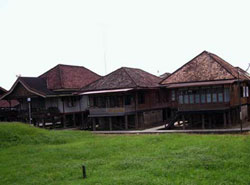Project Members
- Peter Cole (University of Delaware and MPI EVA), PI
- Gabriella Hermon (University of Delaware and MPI EVA), Co-PI
- Uri Tadmor (MPI-EVA Jakarta Field Station), Co-PI
Assistants (Delaware Graduate Students)
- Yanti
- Karthik Durvasula
- Tim McKinnon
Data Collectors and Transcribers (in Jambi)
- Hustarna
- Titin Suryani
- Takiddin
- Heri Mudra
- Aridem Vintoni
- Raden Eko Martadinata
Traditional Jambi Malay

This project was a collaborative effort of the Department of Linguistics, MPI-EVA and researchers at the University of Delaware, with funding from the U.S. National Science Foundation. The project was engaged in the study and documentation of Traditional Jambi Malay, an endangered Malay variety spoken in Jambi Province in southeast Sumatra, Indonesia.
This project studied Traditional Jambi Malay, an endangered Malay variety spoken in Jambi Province in southeast Sumatra, Indonesia. The Malay language originated in Sumatra, and dozens of Malay dialects are spoken on the island, none of which have been well described. Most native speakers of Malay live in Sumatra, many more than in Malaysia, for example. Yet there is not even one thorough grammatical description of a Sumatran Malay dialect. One of the expected results of this project was the first detailed description of such a dialect.
Traditional Jambi Malay is an ideal dialect for a study, because Jambi is widely considered to be original locus of Malayu/Melayu (the Malay-Indonesian term for ‘Malay’). It was from Jambi--and later from Palembang--that Malay spread throughout much of Southeast Asia. Thus, Jambi is an important key to understanding the complex diasystem of hundreds of Malay dialects. While Jambi Malay as a whole is not in immediate danger of extinction, conservative varieties of the language are being rapidly replaced by an urban koine, which is spreading from Jambi City. As a result of the koineization process, many of the distinctive features of Jambi Malay have been lost in Jambi City. As this process spreads to the hinterland, Traditional Jambi Malay will eventually cease to exist.
In addition to grammatical description of Traditional Jambi Malay, the long-term results of this project include:
- Documentation of the language in the form of a computerized database of texts linked to digital recordings in a variety of genres, including narratives, conversations on various topics, songs, poems, riddles, jokes, and ritual texts.
- Two volumes, consisting of oral history and folk tales respectively, to be published locally for the benefit of the community.
- An automatically generated glossary of Traditional Jambi, which can be expanded into a full-fledged dictionary.
- A series of theory oriented studies based on the data.
This project is partly funded by the U.S. National Science Foundation, grant number BCS0444649.
Data archive
- 77 sound files (wav)
- 76 text files (txt)
Contact: lingarchive@[>>> Please remove the text! <<<]eva.mpg.de